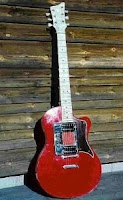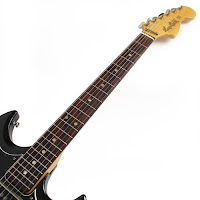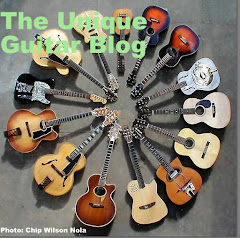 |
| 1952 Supro Ozark |
That guitar was a 1952 Supro Ozark model. The one pickup was unique since the strings passed under the pickup, much like the horseshoe pickups on a Rickenbacker bass guitar. These Supro Ozarks were actually built for steel guitar players.
 |
| Hendrix with a Supro Ozark |
I later learned that this model was Jimi Hendrix’ first guitar. Since then I have been fascinated with these old Supro guitars. They have made a comeback though. That guitar that I could have had for $100 is now worth $900 to $1000 on the vintage market.
 |
| 1930's National Style 0 |
 |
| 1930's Dobro Angelus |
Beachamp also worked with Adolph Richenbacher (later changed to Rickenbacker), who owned a tool and die shop. This shop produced bodies for the early Dobro, aluminum guitars, and also the resonator cones that went into the guitars. At that time guitarists were clambering for a louder instrument. The initial Dobro resonator cones had an inverted bowl shaped single cone with a bridge over its top. This was developed by John Dopyera, but not patented.
National String Instruments began build single resonator steel guitars with a non-inverted metal bowl.
By 1934 the Dopyeras’ had gained control of National. But by 1937 the company was struggling financially.
In 1942 WWII had started, and metal was rationed. This was the year that Victor Smith, Al Frost, and Louis Dopyera (another Dopyera brother) got together to start a new company called Valco with was an amalgamation of V(ictor), A(l), L(ouis) Co(mpany) or Valco.
 |
| 1947 New Yorker |
National had already created some arched top electric guitars, and lap steel guitars in the 1930’s. Production of National guitars started up again in 1947.
By 1952 Valco began manufacturing solid body electric guitars under the National and Supro brand names.
 |
| 1952 Supro Ozark (Oahu) |
These instruments were made of wood, and some were covered in pearloid plastic, commonly known as “mother-of-toilet seat” (my granny had one of those back in the day).
These were the days of Country Music, and electric guitar companies marketed their product to the folks that played Country Music.
 |
| 1957 Supro Dual Tone |
The two position selector switch operated either pickup, but not both at the same time. The “Kord King” neck was painted the same colour as the guitar, and topped with open back Kluson tuners (three on a strip) that had plastic butterfly pegs.
In my opinion, the neck was rather fat. This guitar came in white or black. The pickguard was the opposite colour of the body.
 |
| 1957 Supro Pickups and features |
The Electric Melody bridge pickup was wound in a way to produce a bright slightly overdriven sound.
 |
| 1957 Supro Ozark - Hawaiian Western Pickup |
The Hawaiian-Western unit was used on the Ozark model. The strings passed underneath this pickup. It gave a midrange sound that was conducive to slide guitar playing.
 |
| Supro True Spanish Rhythm Pickup aka Silver Sound |
It was a regular electromagnetic pickup with a coil in the base of the bridge, and two or more magnetic pole pieces suspended from underneath the saddle. This was an early attempt to replicate the sound of an acoustic guitar. This type of pickup was also used in National guitars.
In 1959, Supro introduced several other electric solidbody guitars in addition to the Supro Dual Tone, and the Ozark. The Rhythm Master was an electric guitar that featured two sing coil pickups on the body; the Melody Unit, the Bass Unit, plus the Silver Sound unit, which at the time was referred to as the Spanish Rythm Unit, or just the Rhythm Unit. The shape was similar to the Dual Tone except it had a slight cutaway on the upper treble bout. It also had a German carve around the perimeter of the body. The guitar had one volume potentiomer, and a slider switch.
 |
| 1959 Rhythm Master with Val-Trol |
This guitar also was equipped with Val-Trol. This was a unique Valco feature that consisted of six screw adjustable mini-pots above the saddle and pickups. The player could preset each volume and tone miniature potentiometer to the desired tone/volume with a screw driver. There also was also a removable plate on the back of this guitar.
 |
| 1959 Supro Triple Tone |
 |
| 1959 Supro Coronado |
Though the Supro Coronado, was not a solid body guitar, but actually a maple hollow body without and F-holes and a single cutaway, I am going to include it since it is rather unique. The body featured a two single coil pickups; the bass neck unit, and the neck melody unit, plus the bridge mounted Rhythm Unit or Silver Sound pickup. The three way pickup selector was mounted on upper bout. Beneath the strings were six adjustable mini potentiometers similar to those on the Rhythm Master.
 |
| 1959 Supro Belmont |
The Kord King neck on The Belmont did have a Brazilian rosewood fret board. The guitar came with a compensated wooden bridge. The controls included a volume and tone knob, and a slider switch that turned off the sound.
 |
| 1957 Supro Belmont |
The Belmont was also offered in 1957 as a version was similar in shape, but the pickup was placed In the neck position, and this version only had a volume and tone pot. For both years, the Belmont came with a stamped metal tailpiece.
 |
| Supro Super Series |
The Supro Super Series guitars were short scale instruments. There were two versions. One came with twin pickups, while the other came with just one pickup unit. There was a slider switch on both. The switch on the two pickup guitar activated one pickup at a time.
 |
| 1959 Supro Super Series |
To achieve the short scale on the Super Series, the neck, which was the same one used on the 25” models, was moved forward to join the body at the 12th fret.
So the body had to be routed out to accommodate the additional neck length.
 |
| 1959 33 Special |
 |
| 1957 Supro 33 Special |
By 1962 some of the Supro line remained the same. The Supro Dual Tone was still offered with no changes. The short scale Supro Series was reduced to only the single pickup model. The Belmont also remained unchanged.
 |
| 1962 Supro Ozark |
The 1961-62 Ozark was also offered, but was a much changed instrument. This guitar now included one Melody unit pickup in the bridge position. The action was lowered. The body shaped now included a small cutaway on the upper bout, however it was essentially a Belmont with a different body shape.
 |
| 1962 Supro Kingston |
A new guitar called The Kingston was very similar in shape and accouterments to the Ozark, however the body was made of fiberglass material, which Valco called Res-O-Glass.
 |
| 1962 Coronado II |
The Supro Coronado II was different from the early model. This guitar had a fiberglass body. The Val-Trol controls were gone, and so was the bridge mounted Silver Sound pickup. This guitar came with a Bass Unit pickup, and a Melody Unit bridge pickup. The guitar came with a three-way slider switch, allow each pickup, or both in unison. Controls included volume and tone knobs for each pickup,
 |
| 1962 Supro Bermuda |
The Supro Bermuda was a twin pickup version of the Kingston. It had a molded plastic body, which was different than the Res-O-Glass shells found on other Supro guitars. The Bermuda's slider control activated the neck pickup, or the bridge pickup. This guitar had a single volume and tone knob.
 |
| 1962 Supro Martinique |
This guitar came with the bridge/saddle Silver Sound acoustic unit.
 |
| 1962 Supro Martinique |
 |
| 1962 Pocket Bass |
 |
| Supro Pocket Bass unfinished - back plate removed |
It was called the Pocket Bass, not because it was small, and short scale. There were seven or eight round pockets, about the size of a soup can, routed in the back of the instruments body. Three more slightly smaller routes contained the controls. A black cover was screwed to the back of the body. The guitar came in black, but the Airline models sold through Montgomery Ward were offered in iced tea sunburst.
 |
| 1964 Supro Coronado |
This guitar came with a Valco vibrato unit.
The Martinique was still offered, with no changes to the instrument.
 |
| '65 Tremo-Lectric |
 |
| '64 Suprosonic 30 |
One was the Suprosonic 30, which was a single "Bell Tone" pickup in the neck position. It had the same double cutaway body shape as the Pocket Bass. It had a Valco vibrato system, a wooden compensated bridge, and was only available in red with a white headstock.
 |
| 1964 White Holiday |
The 1964 Supro White Holiday was guitar with a white fiberglass body, and came with a single bridge pickup in the bridge position, and apparently the Silver Sound pickup that was embedded in bridge. This guitar came with a single master volume control, a slider switch, and three tone knobs. It also had the Valco vibrato unit. The literature promised three distinct tonal sounds.
 |
| The Hootenanny aka The Folkstar |
 |
| 1965 Supro Japanese Imports |
The 1965 Supro catalog contained some familiar models However some of these were imported guitars from Japan. The models S525, S535, and S545 were all solid body guitars made in Japan.
 |
| 1965 Supro S555 |
The S555 had the same pickup arrangement, switches and knobs as on the other guitars, but it came with a fiberglass body. This guitar also had the Silver Sound bridge pickup. This guitar had a six-on-a-side headstock. I'm suspect that the neck may have been of Japanese origin.
 |
| 1965 Supro S430 |
The Supro model S430 was a six string guitar version of the Pocket Bass. It came with a single Bell Tone pickup in the neck position, and a Valco tremolo. The back was solid, so I do not believe the pockets were routed into this instrument.
 |
| 1965 Super Seven |
The Super Seven was a budget guitar geared to children that were beginning to play guitar. It had a single pickup in the center of its body, and a very short 22" scale.
 |
| 1965 Sahara |
The Sahara was also a budget model with one pickup in the bridge position, and Supro's standard 24.5 inch scale . It had a fiberglass body, and sold for less than one hundred dollars. The pickguard announced it was a Sahara.
 |
| 1966 Pocket Bass |
There is no longer any mention of the "Kord King" neck in this years literature.
The 1966-67 Pocket Bass was now only a 24 and a half inch scale neck, which was the same scale as Supro guitars from 1962. It may be a guitar neck adapted for bass.
 |
| 1967 Supro Stratford, Carlisle, Claremong, and Croydon models |
Sadly 1967 was the final year that Valco/Supro offered guitars and amplifiers.
They declared bankruptcy that year and the assets were purchased by the Kay Musical Instrument Company. The assets of Kay/Valco were auctioned off in October of 1969.
In 2001, Michael Robinson created Eastwood Guitars to revive and create many older brands of guitars, by using some modern technology. Shortly afterward he acquired the right to the Airline brand name and began offering some reproductions of Valco instruments.
In 2005 Bruce Zinky, who worked for Fender Musical Instruments before setting up his own firm, purchased the Supro brand name to create updated versions of Supro amplifiers.
In 2013 Absara Audio, of Port Station, New York, purchased the Supro name from Zinky. They currently make outstanding Asian reproductions of Supro guitars and amplifiers.
Click on the links under the pictures for sources. Click on the links in the text for further reading.
©UniqueGuitar Publications (text only)
Here is the 2017 Supro Hampton guitar























































